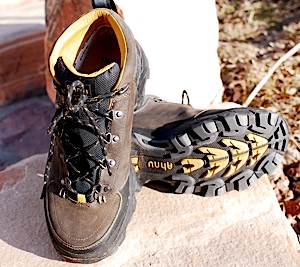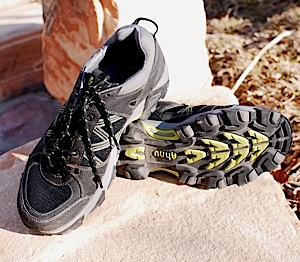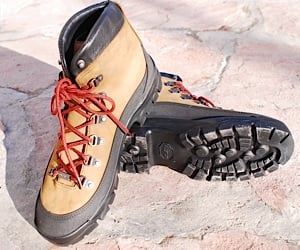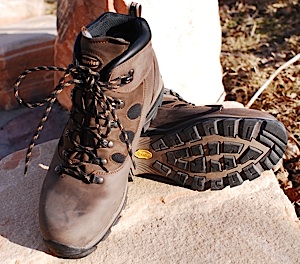What you put on your feet when you're out and about in the national parks goes a long way towards ensuring your comfort. Of your feet, at least.
With that in mind, I put several pairs of boots through the rigors of walking on trails and pavement. There are quite a few boot companies out there, so this is just a small snapshot of what's on the marketplace. That said, I was impressed with the overall quality of the boots we tried.
With an eye towards light-to-midweight hiking needs, I tried the following boots: Ahnu's Elkridge Mid, Ahnu's Moraga Mesh, Danner's Crater Rim, and Zamberlan's 298 Tundra GT. Of course, these four spread across a range of needs, with the Danner and Zamberlan well-suited for multi-day backpacking adventures, while the two Ahnu models are aimed primarily at day hikes. With that understood, let's take a look at what I found.
Right out of the box, these came extremely close to fitting like the proverbial glove.

A great everyday boot, that over-stuffed gusseted tongue could be an issue.
Sizing -- men's 11 -- was spot on, and, in these days of wild color mixes, they are one of the most attractive boots I've seen. Subtle yellow stitching adding just the right highlight to the gun-metal gray leather.
The specs: A mix of full-grain and synthetic leather, with an underpinning of Ahnu's proprietary eVent waterproof/breathable lining. Mid-sole is dual-density EVA foam.
There's a plastic/nylon shank for support, and a rubber Vibram outer sole. Gusseted tongue to keep out trail debris. Two-and-a-half pounds a pair. MSRP: $155 for men's.
As noted, these fit extremely well out of the box, and the combination of full-grain and synthetic leather with the padded lining made the Elkridge Mids very comfortable with no break-in required. The soles proved very sturdy on slickrock and dirt trails alike. Height-wise, these are mid-cuts; just a tad over the ankle, but not fully wrapping the ankle.
Having seldom worn a mid-cut hiking boot, these took a little getting used to in that there's little ankle support. Too, you'd probably want to employ an ankle gaiter to help keep twigs, dirt, and pebbles from jumping inside.
The single flaw I encountered could be a deal-breaker if you're looking to make this your regular hiking boot: the gusseted tongue is so full of padding that I had a hard time cinching down the laces to get a secure fit. Even a locking lace failed to keep the cushy tongue from pushing the laces back out before I could tie a knot.
That said, I've found these comfy boots on my feet almost daily as I knock around town and tackle yard work.
These are a wonderful pair of low-cut shoes that will work great in a variety of outdoor environs. Will you use them on long-distance backpack jaunts? Not likely, unless you already use a lightweight boot with a heavy-weight pack. But everything else is fair game!
The specs: Upper is mostly breathable mesh, though with some leather upper panels for added strength.

A great lightweight trail shoe, though lime green highlights?
Obviously not waterproof. Nylon lining, dual-density EVA mid-sole, Thermoplastic urethane shank. Rubber outer sole. One pound, 14 ounces per pair. MSRP: $110.
As with their big brother, the Moraga Mesh fit great out of the box. In fact, they fit better than the Elkridge Mesh due to the mesh construction that the lacing pulls tight to your foot.
The sturdy shank, paired with a dual-density compression molded EVA midsole, make these a great trail running shoe for places like the Primitive Trail in Arches National Park. And the rubber soles grip well. As for those lime-green highlights, well, you can't always have everything....
My initial thought when I pulled these out of the box was, "Jeez, these are heavy." My initial thought when I pulled them on was, "Jeez these are stiff." When it comes to these boots, however, I learned not to trust my initial thoughts.

Stiff-looking right out of the box, these boots readily eased into the trail.
The specs: Waterproof Nuboc leather upper. Waterproof/breathable Gore-Tex liner keeps your feet dry. An abrasion-resistant rand wraps the boot just above the rubber sole to protect the leather against rocks and roots. Inside, a fiberglass shank topped by a polyurethane footbed provides stability and protection.
Underfoot is a Vibram Bifida Sole that Vibram claims features "the most recent biomechanical concepts in its design... The design of the sole provides natural movement for the foot. The thrust, grip and brake areas are characterized by different shaped lugs positioned according to the most recent biomechanical concepts." MSRP: $300
As noted above, the boots from this venerable American company are deceptive. Once I laced these guys up and headed out onto the trails they didn't seem heavy at all, though they do weigh right around 3.6 pounds a pair (size 10). And while they're definitely stiffer than the Ahnu Elkridge Mids, that, too, is deceptive. Inside, the lining and hand-made mold comfortably wrapped my feet and held them secure up and down the trails. That hefty Vibram sole also provided secure footing.
These boots, with their D-ring lacing and those Vibram soles, are built for wear-and-tear mile after mile after mile in places like the Bechler Region of Yellowstone National Park.
At 6 inches high, they come above the ankle, and that could be an issue for you until they're fully broken in. The stiff collar rubbed a bit more than I liked, but I'm guessing it will soften up with the miles.
Why $300 a pair? These are hand-made in the United States, from the grading of the leather and wrapping of it around the lasts to the stitching and the insertion of the eyelets or D-rings and attaching of soles.
Being Italian-made, perhaps it shouldn't be surprising that these boots are sleek and light, a Ferrari of boots. They wrapped my feet like old friends right out of the box, and climbed the trails like mountain goats.

Zamberlan's Tundra GT was silky smooth from the get-go.
The specs: The one-piece uppers feature the 83-year-old company's proprietary Hydrobloc/Nubuk leather, with Cordura nylon panels cut in for ventilation. A Gore-tex lining keeps your feet dry, while the footbeds are removable for washing. EVA mid-soles, with polypropylene/nylon shank for underfoot support and protection. Gusseted tongue to keep out trail debris. Propriety Zamberlan Air System provides for optimal ventilation and weight reduction (these boots are down 10 ounces from the previous version). The Vibram Zamberlan Revolve soles are an improvement from the 198 model. Two-pounds, 11 ounces a pair. MSRP: $240
Stiffness is not an issue with these boots. The leather was soft and supple where you'd want it to be -- around the tongue, the collar, and where it grips your ankle. Both the Tundra GT and the Crater Rim passed the toe-kick test on the trail: ramming rocks and roots at a good pace without damaging the toes.
Though not as tall as the Danners, the Tundra GTs nevertheless gave good stability around the ankle, and their lightness was appreciated over extended hikes. A great choice for that hike to LeConte Lodge in Great Smoky Mountains National Park.
The Bottomline?
All these boots will serve you well for their specific purposes. The Danners might be a bit much for short dayhikes, but will stand up well to trekking over mountain ranges. Ditto with the Zamberlans.
While all four brands fit well right out of the box, you'd probably be wise to find a shop where you can test these by walking around the store for a while with them on. That said, in today's commerce swapping boots by mail order -- or even ordering two different sized pairs at the same time and returning the one that doesn't fit right -- is a popular practice of some folks.


 Support Essential Coverage of Essential Places
Support Essential Coverage of Essential Places







Comments
I'm looking for polishable hiking boots to wear with my NPS uniform and those Zamberlan's look like the might do the trick. Thanks for the review.